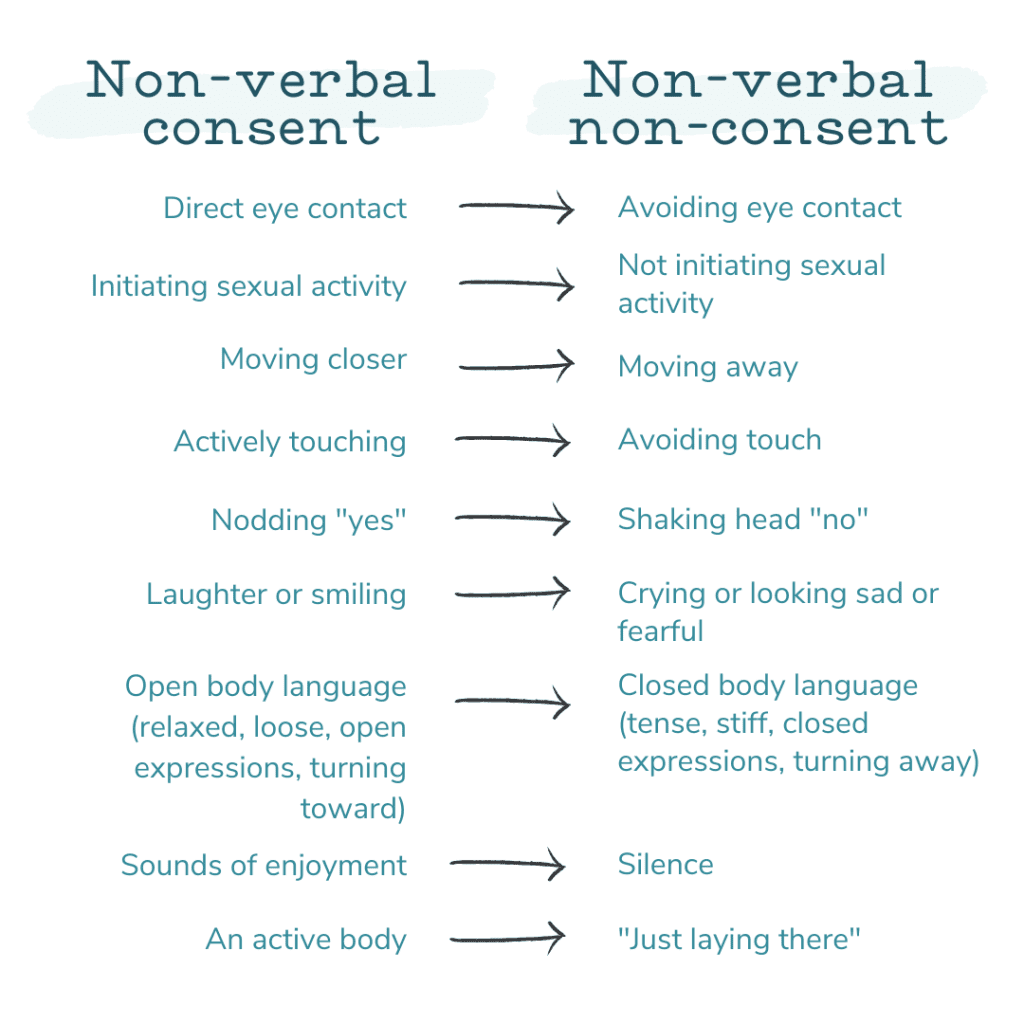SAAM – A Guide to Consent & Boundaries
Everyone wants to have a safe, fun, and exciting physical relationship with their partner. Consent is a necessary and important factor to ensure both people involved feel safe and comfortable. Consent is when someone gives permission for something to happen or agrees to do something.
Typically, consent is used in the context of physical or sexual interactions; however, consent is an important part of all healthy relationships. Asking for consent is an important way to show your partner that you care for them, and to remove any sense of power one partner may feel over the other.
“At its core, consent empowers individuals to feel in control of the decisions surrounding their sex life and intimacy.”
Giving consent can ease discomfort surrounding vulnerable moments, such as sexual intimacy, and opens the door for a meaningful conversation about each partner’s likes, dislikes, interests, and insecurities. In other words, seeking consent can help partners learn about each others’ boundaries.
Boundaries are the limits or guidelines we prescribe to different interactions, activities, and contexts. Boundaries can be personal or professional and can change over time. In order to ensure others understand and respect our boundaries, we need to communicate them directly. In the context of sexual intimacy, communicating personal boundaries assists in establishing consent.
When to ask for consent
Early on in a relationship, asking for consent for non-sexual behaviors such as holding hands, builds a foundation of trust and openness upon which the relationship can grow. These early conversations also provide each person the opportunity to be clear about where their boundaries are from the start.
Always ask for consent before any type of touch, and before escalating things. Consent is also an ongoing consideration. Both partners have the ability to change their minds at any point during the physical interaction. Think of requesting consent as more of an opening up of a conversation rather than a one-time ask. Continually checking in and responding appropriately to your partner’s needs builds trust and shows you respect them.
Consent can be complicated and, in the heat of the moment, it can be difficult to understand its nuances as well as the needs of your partner. Couples are encouraged to have conversations about physical and sexual boundaries way ahead of time, prior to moments of intimacy. Doing so begins an honest conversation about each others’ interests, fantasies, and non-starters. These conversations can be fun, exciting, and sensual while also allowing partners to better understand each others’ comfort zones.
Ask yourself:
- Am I putting additional pressure on my partner to say yes?
- Am I asking in a respectful way that builds trust?
- Am I and my partner in a state where we are able to respond without the influence of alcohol or drugs?
How to ask for consent
When you do ask for consent, it’s important to make it clear to your partner from your words, body language, tone, and expressions that you are ok with their answer, no matter what it is. Expressing your respect for their boundaries goes well beyond the words that you use.
Read into their answer – it also may go beyond the words they use. If your partner says, “yes” or, perhaps a less sure, “I guess” or, “If you want…” pay attention how their body language may be telling you more. If you aren’t sure their answer is an enthusiastic “yes”, air on the side of caution and don’t move further. Change the subject by asking what they want to do instead or offering another activity idea.

Did you get a “yes”? Keep checking in. As you are moving forward, continue to make sure they like what you are doing. Ask, “does this feel good?” or, “what would you like me to do next?” and be prepared to respond respectfully and immediately if they change their mind.
Continue to show care and concern by verbalizing permission to say “no.” By saying something like, “you can stop me at anytime,” or “we will only go as far as you feel comfortable going,” you are both respecting your partner’s boundaries and empowering them to engage in intimacy equally. But, you also need to feel prepared to stop when given directions to do so even if you don’t want to.
Did you get a “no”? Accept their answer. Never try to convince someone to say yes if they have already said no.
Responding to a request for consent
If someone asks you for consent, it shows they want to know your feelings and should respect your truthful answer. If you feel that you cannot be truthful when asked for consent, ask yourself why you feel that way.
If you are unsure about your answer, it might be best to say “no”. Both you and your partner deserve to be 100% certain about what you are doing together. If you are being asked to do something you aren’t sure you’re ready for or you’re not interested in, or you just aren’t in the mood, be honest and state your boundaries.
You can say…
“That sounds nice, but I’m not in the mood right now – I’ll let you know how I feel later”
“I’m not comfortable with that, let’s keep doing what we are doing”
If you are saying no, it can be tough to let someone down. Being honest with them shows that you have respect for yourself and for them. Be clear and firm about your decision, and when possible, offer an alternative activity you can do together.
You can say…
“Thanks for asking, but I don’t feel that way about you.”
“I’m not feeling up to it right now, can we _____ instead?”
If you are saying yes, be specific. Let your partner know what you are agreeing to, where your boundaries lay, and if you have any conditions. Also, remember that you have the right to take back your consent at any point if you begin to feel uncomfortable or need a break.
You can say…
“Yes, I’m into that, but only if you wear a condom.”
Consent is a normal and necessary part of sex. It’s a skill that gets better and easier the more you practice. Learning how to hold your own boundaries and respect those of others will deepen your relationships, build trust, and grow your confidence.
Factors that impact consent:
- Age States have varying laws as to what age an individual can legally consent to sexual activity. In Illinois, a person can legally consent at age 17, which means persons under 17 years old cannot legally consent, even if they are enthusiastic about the sexual activity. It is important to know the age of consent laws to understand any relevant legal consequences.
- Same mental capacity Some individuals learn and function on different levels. Consent is a complex topic and it is important that you and your partner understand and can verbalize it.
- Clear state of mind To ensure consent is communicated clearly and with the proper intent, both parties are encouraged to be sober. Drugs and alcohol both lower inhibitions and impair decision-making.
- No force Consent occurs in the absence of physical force or emotional coercion. Making someone feel guilty, like they can’t leave, leveraging things like money or a ride home, as well as forceful physical contact negates any possibility of consent.
- Equal power between partners Differences in status, such as staff/resident, teacher/student, employer/employee complicates consent as one partner has clear power and influence over the other.
- Must speak the same language Consent requires clear communication! Both parties must be able to communicate in the same language so important details do not get lost in translation.
- Verbal and physical affirmations Consent is communicated explicitly, through our words and language (“yes!”) as well as body language. Do not ignore non-verbal signs of discomfort and hesitation.
Join Our Community.
Sign up for our quarterly newsletter with practice news, timely resources, staff highlights, and other helpful tidbits!
Recent Posts






